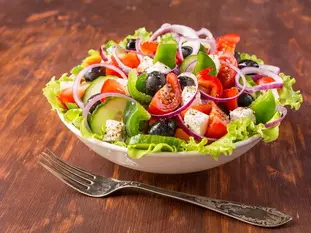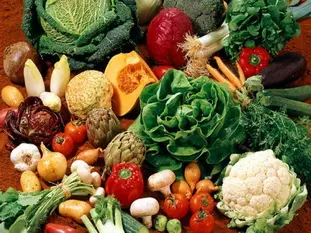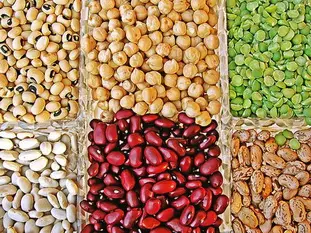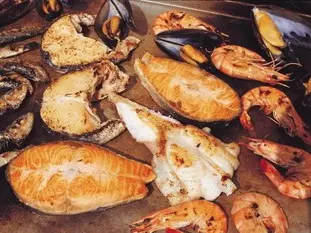This site uses only a few technical cookies necessary for its operation. By continuing to browse, you accept their use.
To find out more...
To find out more...
The infinite variety of salads

Making a salad for a meal, a few ingredients of your choice and a sauce to bind it all together is still one of the best ways to cook something really good quickly and simply.
And since there is often a "fresh" aspect with the vegetables in the ingredients, not only does it taste good, but it's also healthy.
Add to that the fact that if the salad is big enough, it can be the only dish of the meal, perhaps preceded by a small dessert, and why not, accompanied by a good glass of wine, especially in summer.
There are so many advantages to making salads, and there is also an aspect that deserves to be noticed: the infinite variety of ingredients that can be added!
You can eat almost anything in a salad, and therefore put everything in it, or almost...
And since there is often a "fresh" aspect with the vegetables in the ingredients, not only does it taste good, but it's also healthy.
Add to that the fact that if the salad is big enough, it can be the only dish of the meal, perhaps preceded by a small dessert, and why not, accompanied by a good glass of wine, especially in summer.
There are so many advantages to making salads, and there is also an aspect that deserves to be noticed: the infinite variety of ingredients that can be added!
You can eat almost anything in a salad, and therefore put everything in it, or almost...
10 K 4.6/5 (15 reviews)
Keywords for this post:SaladIngredientsDressingVarietyHealthLast modified on: March 13th 2021
The infinite variety of salads
What is a salad?
Let's just say: one or more "things", foods, ingredients, cooked or raw, or both, rather cold but sometimes hot or warm, mixed and bound by a good vinaigrette sauce.Of course, the first one is the salad, green : green salad, herbs if possible, and vinaigrette sauce, classic, unwearable.
There are also the classics, often territorial: Niçoise, Alsatian, Lyonnaise, Piedmontese, tabbouleh, Caesar, ...
But it is very pleasant to go beyond and especially to have several ingredients, to vary the tastes, the colors and the textures.
An anecdote in passing, Gault et Millaut, the gastronomic critics, in their heyday when they first met Paul Bocuse, apparently refused to eat from his menu and asked him to "make us a dish that represents you". The chef made them a warm bean salad, and they (they later wrote) were completely blown away: super-simple, but sublime to eat.
What to put in a salad?
Of course, I'm not going to teach you how to make a salad, and we've already said almost everything about the principle, but here are a few ideas to, perhaps, rekindle your desire to make one.The vegetables

They can all or almost all be eaten in salads, either cooked or raw, or both. There are the classics: carrots of course, tomatoes in season, raw beets, endives (especially at the moment),...
But also : raw cauliflower, Brussels sprouts, green cabbage, zucchini, radishes, mushrooms, cooked potatoes, avocado (yes it is a fruit, an exception here)...
But also : raw cauliflower, Brussels sprouts, green cabbage, zucchini, radishes, mushrooms, cooked potatoes, avocado (yes it is a fruit, an exception here)...
Lentils and peas

They must be cooked, but they are also excellent in salads: rice, white or red beans, lentils, chickpeas, semolina, bulgur, quinoa...
Cooked meats

A salad is also an opportunity to use leftovers and in particular those of meats: white (poultry, a chicken carcass skinned for example, pork, grilled bacon, ...), see red (beef with a leftover roast), without forgetting the delicatessen ...
Fish, shellfish and crustaceans

This is also an opportunity to use leftovers: cubed fish, shrimps, mussels or other shellfish.
LeftoversSalads
are a great opportunity to recycle the leftovers in your fridge, those already mentioned, but also anything that is too small to make a single dish: 1 cooked potato, leftover pasta, a handful of dried fruit, 3 dueling radishes, 1 slice of ham, 1 buckwheat pancake, 1 hard-boiled egg, leftover omelette, cooked rice,... A real inventory, but all this, and many more, can be added to your salad.But also
, Hard boiled eggs or boiled eggs, croutons, sliced or diced cheese, nuts (walnuts, almonds, cashews, hazelnuts...), cooked pasta.Contrasts
Don't hesitate to mix in the same salad foods that are opposites such as cooked and raw, hot and cold, crunchy and soft, it always gives amazing results.For example, try white beans (warm, melting), sliced avocado (cold, melting), slices of pink radish (cold, crunchy) and grilled croutons (hot, crunchy).
The sauces
As mentioned above, the most classic is the homemade vinaigrette sauce, the base, but it is also very interesting to consider more original sauces: remoulade or olive oil and lemon for example, or to "spice up" a classic, such as a vinaigrette with 1/2 teaspoon of Tabasco and 1 teaspoon of soy sauce.Herbs
It's not that they are indispensable, but they are so effective that it would be a shame to do without them. They can all be used, alone or mixed, the classic parsley, chervil, chives, but also the less common, sage, lemon balm, tarragon...You will have understood it, it is enough to pick in all that, or in all that one did not already evoke, to make one of these delicious salads which will sunnify your next meal.
With the kids
One last little thing, I've noticed, and maybe you have too, that kids are very sensitive to the creation of homemade recipes, that you have to name with them, with something fun for them.Creating a salad with a particular mix, often a special one (that's all that was left in the fridge), but with a family name like "Salade de ...", creates a special bond with this dish, a dish that they will ask you for afterwards.
It worked with my kids 20 years ago, I bet it will work with yours :-), if you haven't done it already.
In summary: Salads, in their infinite variety, are a quick and easy way to make delicious meals.
Lasts posts
Butter vs. grease
We often read in a recipe where a pastry is put into a mould that, just before pouring, the mould should be buttered or greased. But what's the difference between these 2 terms?December 1st 20254805
Getting out of the fridge early
Very often when you're cooking, you need to take food or preparations out of the fridge, to use them in the recipe in progress. There's nothing tricky about this: you just take them out of the fridge and use them, usually immediately, in the recipe. But is this really a good method?November 24th 20258975
Who's making the croissants?
When you look at a bakery from the outside, you naturally think that in the bakery, the bakers make the bread, and in the laboratory, the pastry chefs make the cakes. It's very often like that, with each of these professions having quite different ways of working, but sometimes there's also one...November 23th 2025796
Oven height
When we put a dish or cake in the oven, we naturally tend to put it on the middle shelf, and that's what we usually do. But in some cases, this position and height can be a little tricky, so let's find out why.October 8th 20252,3725
The importance of sieving
In recipes that use a fine powder (flour, powdered sugar, etc.), you'll often see the advice to sift before using it. To sift is to pass the powder in question through a sieve (a very fine strainer) before incorporating it into your recipe. It's often advice, but is it really useful?September 3rd 20257,3013
Other pages you may also like
Sorrel and its cooking
Do you like sorrel? This delicious plant with its beautiful bright green leaves, whose subtle acidity goes very well with many other things, including in particular cream, to form with salmon the emblematic dish of the 70's, "Salmon with sorrel" on which was built the beginning of the fame of the...March 19th 202212 K5
Is it really necessary to cream egg yolks?
Let’s try and answer a question that crops up in cookery and patisserie, even if it verges on the existential: do the egg yolks in a custard recipe really need to be beaten until pale, or not?February 28th 201844 K4.3
Should a sausage be pricked before cooking?
If you are using sausages in a recipe, you may have already asked yourself the question: Should you prick it before cooking it, or not? You will certainly find as many opinions "you should prick" as "you should not". Let's try to untangle all this.September 29th 201848 K4.1
For well opened (puffed) cakes
It's always nice to have a well puffed up cake after baking, not only will it taste good but it looks great too. Let's see how to get this beautiful shape almost every time.January 23th 201935 K4.2
Well-cooked meat
Have you ever noticed that if you like your meat well done, it invites strange looks? For instance, in a restaurant, when asked “How would you like that cooked?” If you reply, “Well done,” it is almost as if you are swearing….May 21th 201134 K 14.4
Post a comment or question
Follow this page
If you are interested in this page, you can "follow" it, by entering your email address here. You will then receive a notification immediately each time the page is modified or a new comment is added. Please note that you will need to confirm this following.
Note: We'll never share your e-mail address with anyone else.
Alternatively: you can subscribe to the mailing list of cooling-ez.com , you will receive a e-mail for each new recipe published on the site.









